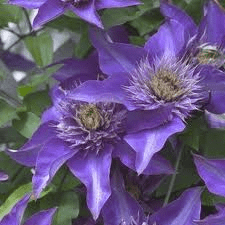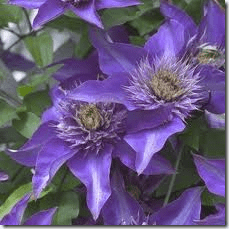Blooming twice a year with double-layered flowers, Multi Blue clematis is hardy from U.S. Department of Agriculture zones 4 to 8 and can reach 10 feet in height. Different varieties of clematis can be propagated in one of several ways. For this variety, layering is the easiest method of propagation. While Multi Blue can also be propagated from cuttings, this requires more work, materials and supervision. In the layering method, a few simple steps allow the plant to do all the work.
- Difficulty:
- Moderately Easy
Instructions
things you’ll need:
- Sulphur or lime
- Small knife
- Hormone powder
- Cotton ball
- Prepare the soil where you plan to place the Multi Blue clematis prior to propagating. It is recommended that a soil test be performed to verify the soil pH — this can usually be done through a county extension office for a nominal fee. Clematis prefers a level of 7 to 7.5. Add sulphur or lime to bring lower numbers into range, if necessary.
- Choose a long stem from the clematis that you will be propagating. Look it over carefully to make sure it is healthy, vital and free of any obvious disease or health issues.
- Bend the clematis stem down gently to the prepared soil. Do not place too much strain on it as it is bending, or the stem may break.
- Use a small, sharp knife to make a shallow cut lengthwise across the bark of the stem. Using a cotton swab, dust the cut with hormone or rooting powder. If you do not have a knife, you can gently twist the stem to create a break in the bark; however, do not twist so tightly that it breaks off the entire clematis stem.
- Bury the cut portion of the stem under garden soil, covering lightly — take care to do so gently. Make sure the clematis is not buried deeply; shallow covering is necessary.
- Anchor the buried stem with a weight of some kind, such as a stone, brick or small garden statute. Water the stem deeply, making sure the soil is saturated. Water regularly, especially during the summer months. Like all clematis, Multi Blue needs moist soil and cool roots.
Tips & Warnings
-
Layering can also be done in pots set around the original plant.
-
Placing mulch around the layered plant stem will preserve moisture and provide some sun protection for the roots as they form.
-
Multi Blue clematis does better in a spot that does not receive full sun; partial shade is recommended.
-
It can take up to a year for the new clematis to root with the layering process.
-
Clematis requires a yearly fertilization.


Deprecated: strpos(): Passing null to parameter #1 ($haystack) of type string is deprecated in /home/agriviek8Qv/agriviet.net/public_html/wp-includes/comment-template.php on line 2522